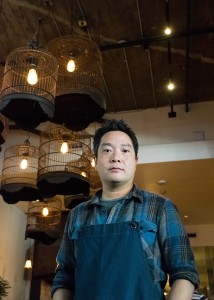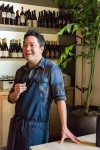Bryant Ng comes from a family of restaurateurs.
The alumnus used to help out in the kitchen of his parents’ restaurant, Wok Way, washing dishes and peeling shrimp. Sometimes, they even let him put food in the fryer.
Ng’s grandparents also opened a Polynesian- and Cantonese-style tiki restaurant, Bali Hai, in Culver City more than 60 years ago when drinks were still 50 cents. He said his family’s history of running restaurants eased his transition into cooking and gave his parents a sense of security when he switched from a stable career path into the more uncertain restaurant industry.
“I loved the environment, the immediacy of everything,” he said. “We serve the food, it goes out, someone eats it.”
Ng graduated from UCLA in 2000 with a degree in molecular, cell and developmental biology and began working as a consultant in San Francisco’s biotech industry. However, Ng said he soon grew tired of his 9-to-5 lifestyle, which involved sitting in front of a computer and drudging through a daily routine, and made the permanent switch to pursue cooking a couple years later. He made his first forays into the culinary world by taking a three-month course at Le Cordon Bleu in Paris, the shortest one it offered so that he could start working as soon as possible, he said.
After years of working in French and Italian kitchens in Los Angeles and New York, Ng opened his own restaurant, Cassia, in Santa Monica as co-owner and head chef in 2015, just 3 miles from the restaurant his grandparents had owned. Ng said Cassia’s menu ultimately represents the natural product of his family’s heritage and his experience working in French kitchens.
The menu’s Southeast Asian influence combines Ng’s Chinese heritage and his wife’s Vietnamese upbringing. Although Ng has worked in French kitchens in LA and New York, much of the restaurant’s French influence was already present in Vietnamese cuisine because of French colonialism, he said.
Andrea Nguyen, a food writer and friend of Ng’s, said when the French arrived in the 19th century, they introduced a romanized system of spelling that facilitated clearer communication, especially with regards to food and the assimilation of culture. As a result, French-influenced food became popular in Vietnam, and the Vietnamese began to adopt parts of French cuisine as their own.
“What we know as popular Vietnamese food – banh mi sandwiches, pho, flan, coffee with condensed milk – all this stuff that has become super popular in terms of the Vietnamese repertoire is somehow attached to the French,” Nguyen said.
Near the beginning of the 20th century, people referred to the Vietnamese baguette as “French” or “Western” bread, but after the Vietnamese began consuming bread on a regular basis, they dropped the French modifier and it became known as “banh mi,” said Nguyen.
Nguyen said the cultural adaptability appears in another popular Vietnamese dish, pho. Prior to French colonization, cows were used as draft animals in Vietnam. But after arriving, the French began consuming the cattle, eating only the tender cuts. The Vietnamese used the components that were left over – the scraps and the bones – to create a broth for their noodle soup.
Ng said he incorporated the history of pho into his Vietnamese version of “pot au feu,” a traditional French one-pot stew. He infused the stew with the beef broth along with other Vietnamese flavors such as cinnamon and charred vegetables.
“It’s not like this huge crazy change. I mean you look at the dish, it can be traditional in certain ways, but the broth is different,” he said. “So when you eat it, there’s just subtle sort of changes in there.”

Kim Luu-Ng, Ng’s wife and co-owner of Cassia, said when researching for the menu, Ng asked her what she grew up eating. Luu-Ng’s family, who fled Vietnam as refugees when she was 2 years old, originally lived in Quang Ngai, a small province located in the central region of the country. She said the typical fare of the region was comprised of what was known to be peasant food, which included boiled and stir-fried vegetables prepared for dipping in a Vietnamese fish sauce.
As a result, Luu-Ng grew up eating meals consisting of cooked cauliflower and cabbage. This inspired a fried cauliflower dish on the menu, along with the traditional fish sauce. Many of the vegetable and seafood dishes are reminiscent of the Vietnamese food Luu-Ng said she’s accustomed to eating – fresh and prepared on the day.
“A lot of the dishes are just a reflection of the way that I ate growing up with my mom,” she said.
The hybridity of the menu extends to the physical space occupied by the restaurant. Ng said the expansive interior is modeled after a French brasserie, a large, bustling restaurant, with concrete walls and long stretches of mirrors. However, next to the stone walls, wired bird cages from Vietnam house hanging light bulbs, and pots of vermicelli broth sit on kitchen stoves ready for prep.
The restaurant itself encompasses more than just Southeast Asian and French cuisines, Ng said. He also incorporates American flavors and local ingredients, as is the case with his long beans and avocado dish, an experimental combination of California produce and traditional Chinese food. Although typically labeled as a fusion restaurant, Ng said he finds it difficult to categorize the food he creates.
“What I’m trying to cook is not some contrived thing that we sit in the boardroom and put on a PowerPoint (to) try to figure out … flavor combinations for,” Ng said. “It’s actually more organic … and it’s part of who I am, what we do and the environment that I’m in.”
